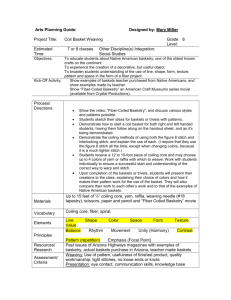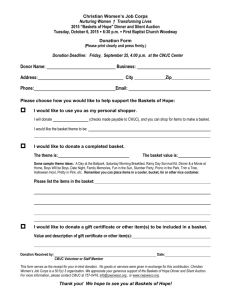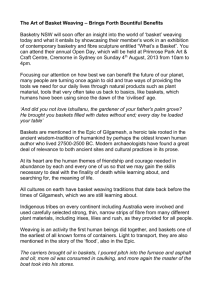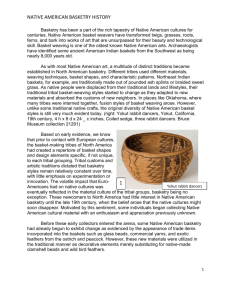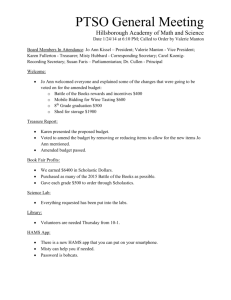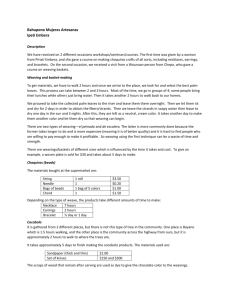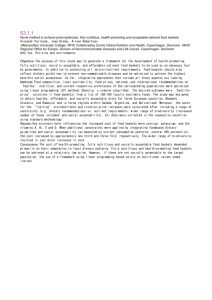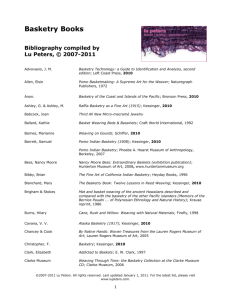Basket weaving (also basketry, basket making, or basket making) is
advertisement
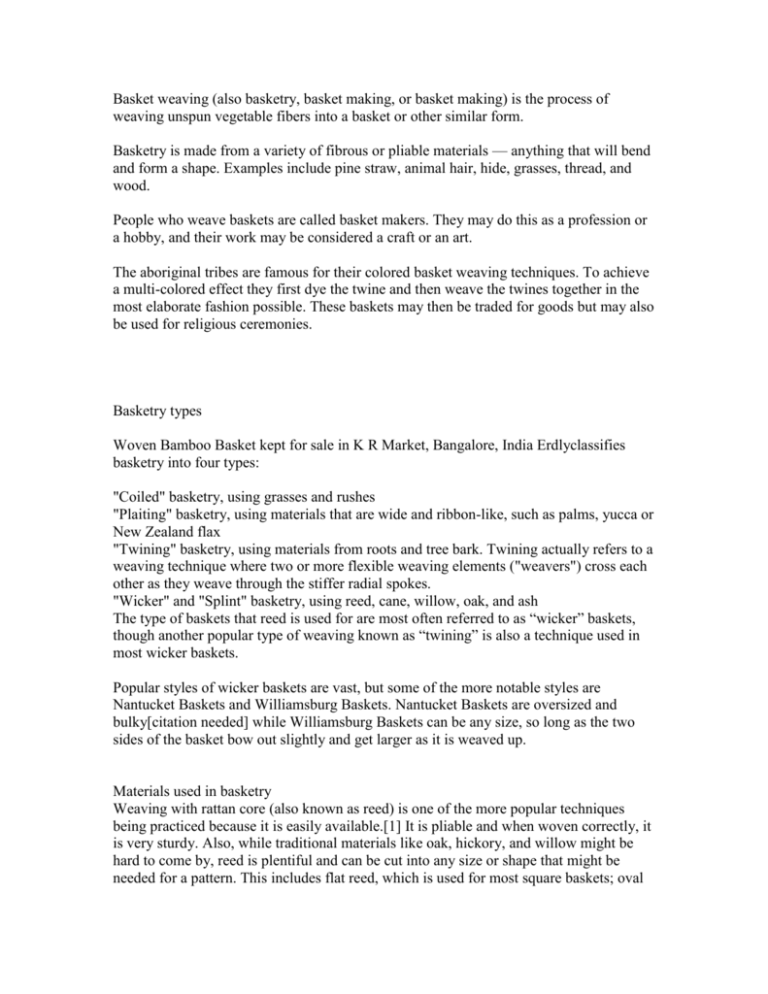
Basket weaving (also basketry, basket making, or basket making) is the process of weaving unspun vegetable fibers into a basket or other similar form. Basketry is made from a variety of fibrous or pliable materials — anything that will bend and form a shape. Examples include pine straw, animal hair, hide, grasses, thread, and wood. People who weave baskets are called basket makers. They may do this as a profession or a hobby, and their work may be considered a craft or an art. The aboriginal tribes are famous for their colored basket weaving techniques. To achieve a multi-colored effect they first dye the twine and then weave the twines together in the most elaborate fashion possible. These baskets may then be traded for goods but may also be used for religious ceremonies. Basketry types Woven Bamboo Basket kept for sale in K R Market, Bangalore, India Erdlyclassifies basketry into four types: "Coiled" basketry, using grasses and rushes "Plaiting" basketry, using materials that are wide and ribbon-like, such as palms, yucca or New Zealand flax "Twining" basketry, using materials from roots and tree bark. Twining actually refers to a weaving technique where two or more flexible weaving elements ("weavers") cross each other as they weave through the stiffer radial spokes. "Wicker" and "Splint" basketry, using reed, cane, willow, oak, and ash The type of baskets that reed is used for are most often referred to as “wicker” baskets, though another popular type of weaving known as “twining” is also a technique used in most wicker baskets. Popular styles of wicker baskets are vast, but some of the more notable styles are Nantucket Baskets and Williamsburg Baskets. Nantucket Baskets are oversized and bulky[citation needed] while Williamsburg Baskets can be any size, so long as the two sides of the basket bow out slightly and get larger as it is weaved up. Materials used in basketry Weaving with rattan core (also known as reed) is one of the more popular techniques being practiced because it is easily available.[1] It is pliable and when woven correctly, it is very sturdy. Also, while traditional materials like oak, hickory, and willow might be hard to come by, reed is plentiful and can be cut into any size or shape that might be needed for a pattern. This includes flat reed, which is used for most square baskets; oval reed which is used for many round baskets; and round reed which is used to twine. And reed can also be dyed easily to look like oak or hickory. The basket weaving process The parts of a basket are the base, the side walls, and the rim. A basket may also have a lid, handle, or embellishments. The 'static' pieces of the work are laid down first. In a round basket they are referred to as 'spokes'; in other shapes they are called 'stakes' or 'staves'. Then the 'weavers' are used to fill in the sides of a basket. A wide variety of patterns can be made by changing the size, color, or by placement of a certain style of weave. History While basket weaving is one of the widest spread crafts in the history of any human civilization, it is hard to say just how old the craft is because natural materials like wood, grass, and animal remains decay naturally and constantly. So without proper preservation (which was not available two hundred years ago, much less two thousand years ago) much of the history of basket making has been lost and is simply speculated upon. The oldest known baskets have been carbon dated to between 10,000 and 12,000 years old, earlier than any established dates for archeological finds of pottery, and were discovered in Faiyum in upper Egypt.[1] Other baskets have been discovered in the Middle East that are up to 7,000 years old. However, baskets seldom survive, as they are made from perishable materials. The most common evidence of a knowledge of basketry is an imprint of the weave on fragments of clay pots, formed by packing clay on the walls of the basket and firing. During the Industrial Revolution, baskets were used in factories, and for packing and deliveries. Wicker furniture became fashionable in Victorian society. During the world wars thousands of baskets were used for transporting messenger pigeons. There were also observational balloon baskets, baskets for shell cases and airborne pannier baskets used for dropping supplies of ammunition and food to the troops.[2] The technique of weaving has been passed along, re-discovered, and expanded upon throughout the years, and is still being expanded upon today. Baskets were at one time used simply for storage and transportation of goods. Decoration was an afterthought at best. Today, functional baskets are still in use, but many are made for more decorative purposes. Patterns and “how to” books are now available for anyone to learn the craft. Native American basket weaving Seri basket of the haat hanóohcö style Native Americans made their baskets from the materials available locally. In New England they wove their baskets from Swamp Ash. The wood would be peeled off the felled log in strips, following the growth rings of the tree. They also wove baskets from sweet grass. Northwestern tribes used spruce root, cedar bark, and swamp grass. Southeastern tribes like the Cherokee used bundled pine needles. Southwestern tribes coiled baskets from sumac, yucca, and willow. In northwestern Mexico, the Seri people continue to "sew" baskets using splints of the limber bush plant, Jatropha cuneata. Arctic and Sub-Arctic tribes use baleen, and incorporate ivory and whale bone. Birch bark was used by Northern tribes like the Dene. Birch bark baskets are often embellished with dyed porcupine quills.
